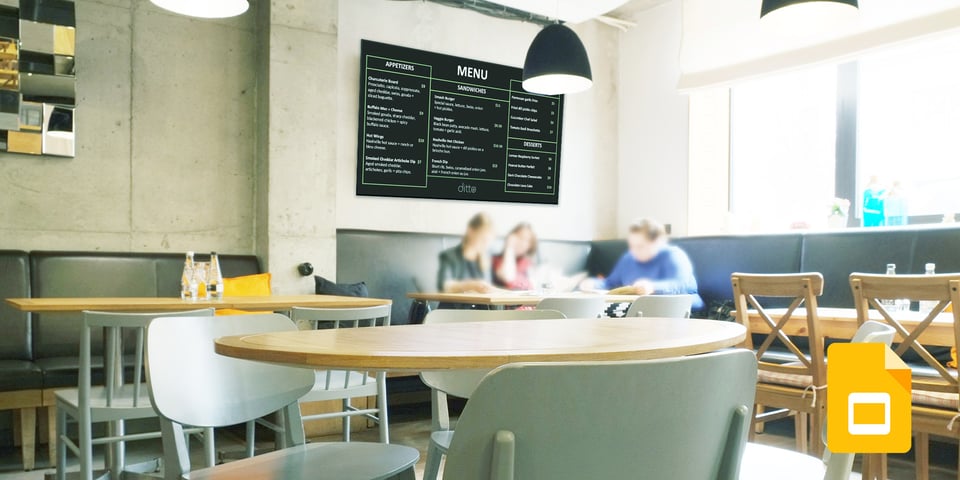How to Screen Mirror iPhone 17
iPhone 17 makes screen sharing and media streaming fast and easy. This guide shows you how to wirelessly mirror iPhone 17 to TVs, projectors or...
3 min read
Squirrels Aug 11, 2020 9:30:00 AM

Creating and editing digital menu boards has never been easier. Digital menu boards are prominent features of many retail stores and food businesses. The ability to edit menu items, pricing and designs quickly and easily is crucial. A slideshow app like Google Slides is perfect for the job.
People in the food and retail industry have a problem: Customers lack the information they need to make informed buying decisions. They have a million questions and skim read most signage (if at all). If your digital menus are clear, concise, highly visible and up to date, you’re one step closer to solving the problem.
That’s why we created this guide and free templates to get you started with digital menus. If you can use basic slideshow software, you can make a digital menu board. It’s that simple. This guide shows you how to configure an easy-to-use tool like Google Slides for digital menu boards. In just minutes, you can turn a slideshow into signage that makes people pay attention and take action.
Make sure your slides are the correct size to best fit the displays in your organization. Don’t place square menus on widescreen TVs.
How to change your slide size:
Creating and designing content for digital menu boards doesn’t have to be difficult. Start with Google’s default templates if you need design inspiration. Keep things simple, legible and relevant.
How to access Google Slide templates:
Want to learn more about menu boards and digital signage? Check out these helpful articles:
Now it’s time to turn your Google Slideshow into digital menu boards:
Ensure the file format you choose is compatible with your digital signage service. Most digital signage content management systems (CMS) will accept common image and video files. For example, Ditto digital signage is compatible with a variety of media file types, such as PNG, JPEG, GIF and MP4.
Make sure to set up your slides to the correct aspect ratio and export them to the correct dimensions. Your slides should fill up the entire screen of your TVs and monitors.
Common display dimensions:
|
|
HDTV |
4K TV |
|
Pixel dimensions: |
1920 x 1080 px |
3840 × 2160 px |
|
Aspect ratio: |
16:9 |
16:9 |
These dimensions can vary depending on what displays your organization uses.
You can export your slides as static images or use a third-party add-on to combine them into a single video file that plays all slides for a set amount of time.
Now that you have exported your slides, it’s time to get them up on your screens. Some digital signage solutions only play files from a physical source like a USB drive. However, the best type of menu board and digital signage service includes a CMS that is touch-free and accessible from anywhere.
Organize your content and set scheduling and duration parameters. To do this you’ll need to upload the files to your preferred signage solution or deploy physical hard drives loaded with your content to each display. The digital signage solution you use can make this process easy or time-intensive — opt for a centrally managed solution that has a built-in CMS, like Ditto.
Now your displays will begin playing the digital menu board content you created from Google Slides.
Save design time and free up your workflow with these easy templates.
GET MY FREE TEMPLATES
iPhone 17 makes screen sharing and media streaming fast and easy. This guide shows you how to wirelessly mirror iPhone 17 to TVs, projectors or...

HDMI cables. Document cameras. DVD players. Dongles and adapters. Many classrooms still rely on these old technologies, but students and educators...

Digital signage is getting easier every day thanks to AI-powered design tools and signage management software. This guide helps schools and business...

1 min read
Survival in the retail and food industry might depend on your ability to quickly create and edit eye-catching digital menu boards. Yeah, it’s that...

1 min read
Digital menu boards are key to any retail or service business — be it a bar, restaurant, retail shop or cafeteria. You can easily create and edit ...

Google Slides is a free tool you can use to create digital signage. Google’s simple slideshow app allows you to easily create digital signage content...


Save when you buy AirParrot and Reflector together. One AirParrot and one Reflector license for use on either MacOS or Windows.
BUY US$

Save when you buy AirParrot and Reflector together. One AirParrot and one Reflector license for use on either MacOS or Windows.
BUY US$